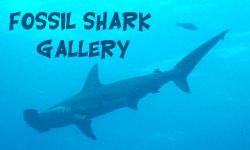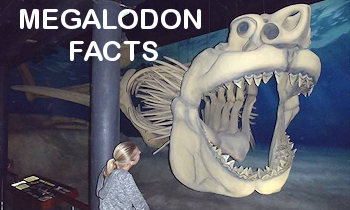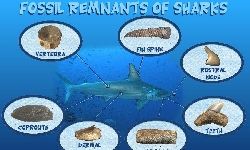Great White Shark Facts
YOUTUBE VIDEO - Swimming with a Great White Shark
Awesome video of a free diver riding the fin of a Great White Shark.

Great White Sharks (Carcharodon Carcharias) off Guadalupe Island. Credit: Elias Levy. [C.C. by 2.0]
Fast Facts about Great White Sharks

Great White Sharks (Carcharodon Carcharias) off Guadalupe Island. Credit: Elias Levy. [C.C. by 2.0])
Name:Carcharodon carcharias
The genus name Carcharodon comes from the greek words meaning "Ragged Tooth"
The species name carcharias comes from greek meaning "point of shark" or "Type of Shark"
Common names include the Great White Shark, the White Shark, and in Australia, the White Pointer
Taxonomy:
Order: Lamniformes - Family: Lamnidae - Genus: Carcharodon - Species: Carcharias
Age: Miocene to Recent
The Great White species C. carcharias originates sometime in the Late Miocene, possibly 6 or 7 million years ago.
Distribution: Global
Great Whites are found globally in near-shore and off-shore temperate waters. Sometimes they can be found in tropical waters,
but are not found in arctic waters.
Common locations include Western U.S., Eastern U.S., South Africa, and Australia.
Body Size:
4.5 - 6.1 m (15 - 20 feet)
They are the worlds largest predatory fish. Adult lengths vary from 15 to 21 feet, although anything over 18 feet is rare.
Most accounts of Great Whites over 20 feet are unreliable, or cannot be confirmed.
They can weigh over 5000 lbs.
Diet: Sea Lions, Seals, Small Whales
They usually feed on marine mammals, such as Seals, Sea Lions, and Small Whales. They will also
scavange off large carcasses. Younger Great Whites will eat sea turtles and fish...
Basically anything they can get their jaws on!
Physical Appearance:
Great Whites have a white underbelly and a grey dorsal side. They are torpedo shaped with a large, powerful tail. Their jaws contain
rows of serrated teeth (like steak knives).
Conservation Status:
Population estamates for Great Whites are not known, but they appear to be rare.
Great Whites are listed as Vunerable by the IUCN. It is also a protected species in some locations.
Shark Attack!:
Contrary to many movies and the media, Great Whites do not consider humans as a food source. They will not
actively hunt and eat humans (Just look at the video at the top of this page!).
Most shark attacks come from the Bull Shark.
However, due to its size, there is a much higher fatality rate in the few Great White shark attacks.
Fun Facts:
Distance Travelers! Tagged Great Whites have been tracked traveling back and forth between California and Hawaii,
and Australia and Africa! This means their populations may be smaller than expected.
Ambush!
Great Whites perfer to ambush their prey. They will often sneak up on a seal or sea-lion from below, and shoot up
to the surface to attack. Sometimes they are traveling so fast, they breach, or leave the water, when grasping the prey.
Big Nose!
A Great White can smell a tiny drop of blood in 26 gallons of water (100 litres)!
Built for Speed! They are fast! Great Whites can swim in bursts up to 25 mph (40 km/hr)!
Great White Shark Facts and Information - The Details

Great White Shark (Carcharodon Carcharias)Credit: Terry Goss [GFDL, CC-BY-SA3.0]
Carcharodon carcharias (Smith, 1838)
The Size of Great White Sharks
The Great White shark, Carcharodon carcharias, is a top predator today. Besides the plankton-feeding Basking and Whale sharks, Great Whites are among the largest of flesh-eating sharks (The Greenland shark is also slightly larger).
Since they are some of the largest sharks, there are lots of "fish tales" in pop culture about their sizes.
The Official Size:
According to the FAO, Great Whites range on average between 4 feet (1.3 m) and 18 feet (5.5m).
As for the largest one ever caught, the
Canadian Shark Research Laboratory reports the largest Great White ever accurately measured was 20 feet (6.1 m). This female shark was caught in a net in 1988 off Prince Edward Island in Canada.
Unofficial Sizes:
Reports of larger Great Whites abound, but have not been scientifically verified. Notable "fish tales" include:
The Cojimar Specimen: This Shark was caught in Cuba in 1945. It was estimated to be 6.4 meters (21 feet) in length.
However, photo analysis of this shark by the ReefQuest Center for Shark Research indicate the shark was much smaller,
around 16 feet in length.
The Seven Star Lake Shark: This Great White was caught in a net in Taiwan in 1997. It was estimated to be around
6.7 meters (22 feet) in length. This is not scientifically verified though.
The 1985 Australian White Pointer: This Great White was caught by Vic Hislop. The shark was reportedly
measured at 6.6 meters (21.6 feet). Again, it was not scientifically verified.
So, What is the worlds largest Great White Shark?
We don't know! Measurements of the large ones are not verified. However, because of the many reports of larger sharks,
it's probable that Great Whites can reach sizes over 20 feet in length. Also, based
on fossil Great White teeth, it is known they can reach larger sizes.
From studying fossil teeth, Michael D. Gottfried extrapolated the size of these prehistoric Great Whites using living Great Whites.
He reached a size of 7 m (23 feet) for these huge Great Whites (Michael D. Gottfried, et al. 1996: figure 3).
Finally, here is a video showing Deep Blue, A female Great White Shark that was tagged in 2013
off of Guadalupe Island. A researcher, Mauricio Hoyos Padilla, estimates her length to possibly be over 20 feet.
YOUTUBE VIDEO - An exceptionally large Great White Shark
This video shows an exceptionally large Great White captured on video.
The Distribution of Great Whites
Great Whites are usually found near shore and globally in all tropical and temperate waters. In the Americas, they
range from southern Alaska and Nova Scotia down to Chile. In Eurasia, they range from Russia to New Zealand, and
Britain to South Africa. Famous Great White locations include California, Australia, and South Africa.
Recent studies of tagged Great Whites indicate they routinely migrate great distances. A California population travels back and forth
to Hawaii, while a population of Great Whites in Australia travel to Africa!
Great White Diet
Great Whites favorite food consists of pinnipeds, such as sea lions and seals. Populations of Great Whites can often be found
near sea lion and seal colonies. When younger, Great Whites will feed on a variety of food, including fish. However, when they reach adulthood, they feed almost
exlusively on pinnipeds.
Recently a tracking tag on a 9 foot Great White was recovered. After looking at the data gathered by
the tag, it appears the tag and the shark it was on was eaten. The researchers concluded a larger Great White (16 ft) ate the smaller (9 ft) Great White.
Recommended Shark Books
 High Quality Shark Teeth by Fossilera
High Quality Shark Teeth by Fossilera
The History and Evolution of The Great White Shark (Charcarodon) in a nutshell

This is an image of the transitional White shark - C. hubbelli. This is the holotype that was found in Peru.
For more information on C. hubbelli, including many more images, go to the Prehistoric White Sharks page.
Great White sharks DID NOT EVOLVE FROM MEGALODON SHARKS,
they are distantly related to Mako sharks and diverged sometime in the Late Eocene or Early Oligocene perhaps 30 or 35 million years ago.
The origins of Great Whites (Carcharodon carcharias) was unclear until fossil evidence was found in the 2000's. Particularly, in 2009 paleontologists
were able to study (Ehert et al., 2009) a "smoking gun", an associated specimen found in Peru back in 1988. This specimen clearly indicated Great Whites
evolved from an extinct group of Mako sharks. Finally, in 2012, a newer study (Ehret el al., 2012) solidified any doubts about this specimen and its place in the geologic record.
We can now trace the ancestry of the Great White shark (Carcharodon carcharias) from one chrono species to the next. A reasonable lineage is as follows:
- Isurolamna inflata: Paleocene
- Macrorhizodus americana (M. praecursor): Eocene - Early Oligocene
- Carcharodon flandricus: Oligocene
- Carcharodon plicatilis: Middle Miocene - Pliocene
- Carcharodon hubbelli: Late Miocene
- Carcharodon carcharias: Late Miocene - Recent

This is a set of transitional White shark teeth, showing the gradual increase in serrations.
It starts with C. plicatilis on the left, goes through various stages of C. hubbelli, and ends up with C. carcharias on the right. The
rightmost tooth is a modern Great White. All fossil teeth are from Peru. All teeth are from the collection of Russ Jones.
For more information transitional White sharks, including many more images, go to the Prehistoric White Sharks page.
Evidence for Great Whites evolving from an extinct group of Mako sharks is briefly discussed below:
1. Associated Dentition comparisons of Megalodons, Makos, and Great Whites.
The teeth dentitions of Megalodons are very different than Great Whites.
Great Whites have a third upper tooth in their dentition that is reduced in size. This allows for more bite pressure on the first two teeth.
This peculiar characteristic is also seen in all mako shark dentitions, but not in megalodons.
The reduction in the third upper tooth is a big evolutionary change.
One would see transitional fossils of the third tooth slowly being reduced over time. When looking at megalodon dentitions, such as the associated dentition NCSM 13073 from Purdy et al., 2001, and other associated sets, we see no reduction in the third upper tooth. The third tooth remains fairly large and robust in megalodons.
2. The serrations on Megalodons and Great Whites are very different.
Megalodon teeth have very small, regular, and refined serrations.
Great Whites have very course, rough, and irregular serrations.
The serrations are completely different
In 2006, Nyberg et al, did a morphometric analysis (a very detailed structure analysis).
of various carcharocles species, Mako species, transition fossils, and Great Whites. They concluded
Great Whites evolved from ancestral Mako sharks and not the Megatooth sharks.
3. The C. hubbelli transitional fossil from Peru.
This is the Peruvian specimen found in 1988 from the Pisco formation.
In 2009 Ehert et al., studied it and pointed out its similarities to C. hastalis and C. carcharias
Also, in 2012, Ehert et at. re-studied the specimen and, more importantly, re-dated the sediments of the formation it came from. The age of the fossil was pushed back by 2 million years. Based on the new date, they concluded C. hubelli was a transitional fossil.
The Failed "Great Whites"
A relatively large, broad, serrated tooth design seen in Great Whites has independantly emerged in the fossil record a few times before. The text below discusses some of these failed "Great Whites."
To learn all about the other prehistoric White Sharks, go to the Prehistoric White Shark Page.
Carcharomodus escheri:
The White Shark lineage produced another serrated shark, called Carcharomodus escheri. Although it superficially looks like a C. carcharias,
this species is too old to be in the lineage, as it arose in the mid Miocene possibly from C. hastalis.
It also only appears in the Atlantic Ocean (Eastern North America and Europe).
The species only lasted a few million years before becomming extinct.
Paleocarcharodon orientalis:
This is a medium sized serrated Mako/Mackerel looking shark with side cusps. It's
found worldwide and was a very short lived species that appears and disappears in the Paleocene.
It is not related at all to modern Great White sharks.
If you want to see what one of these paleocharcharodon fossil shark teeth looked like, go to the
Potomac River page of this website, and look at the "Sample of fossils found" section.
Carcharocles (Otodus) sp.:
The whole lineage of Megatoothed shark is extinct.
These giant serrated monsters arose in the Eocene and became extinct in the Pliocene. The whole genus is not related to
modern Great White sharks. These huge super predators simply became too specialized for their own good.

Closeup of the jaws of Carcharodon hubbelli from the Pisco formation of Peru. C. hubbelli is a transitional fossil that has
characteristics of both a Carcharodon carcharias and a Cosmopolitodus (Carcharodon) hastalis shark.
Image Credit: Jeff Gage/ Florida Museum of Natural History
Great White Shark Tooth Morphology / Identification:
The following fossil shark tooth I.D. diagrams show Great White Shark teeth.
For all of the other Extinct White sharks, visit the Extinct White Shark Page for Giant Whites, Hooked Whites, Escher's Whites, and more.
Carcharodon carcharias (Great White Shark)
Carcharodon carcharias are most similar to the Giant White shark, C. hastalis [broad form] teeth. The difference, of course,
is the serrations. C. carcharias have medium to coarse serrations that are irregular.
Irregular means the serrations are not all a constant size as in C. megalodons. Instead,
the size of each serration varies. This is shown in the diagram below. The Great Whtie Shark is also
slightly smaller than the extinct Giant White shark.
A transitional species C. hubbelli has been found in Peru. The teeth of C. hubbelli are partly serrated.
Examples of Great White Shark Fossils
Great White Shark
Charcarodon carcharias (Linnaeus, 1758)
References / Works Cited
Ehret, D. J., H. Hubbell, and B. J. MacFadden. (2009) Exceptional preservation of the white shark Carcharodon (Lamniformes, Lamnidae) from the early Pliocene of Peru. Journal of Vertebrate Paleontology, 29:1-13. BioOne
Ehret, D. J., MacFadden, B. J., Jones, D. S., Devries, T. J., Foster, D. A. and Salas-Gismondi, R. (2012). Origin of the white shark Carcharodon (Lamniformes: Lamnidae) based on recalibration of the Upper Neogene Pisco Formation of Peru. Palaeontology, 55: 1139-1153. doi: 10.1111/j.1475-4983.2012.01201.x
Gottfried, Michael D., Compagno, Leonard J. V., and Bowman, S. Curtis. (1996). Chapter 7. Size and skeletal anatomy of the Giant Megatooth shark Carcharodon megalodon. pp. 55-66. IN: Klimley, A. Peter, and Ainley, David G. (editors). In: Great White Sharks the Biology of Carcharodon carcharias Academic Press. San Diego, CA. 517 pp.
Jurgen Kriwet, Heike Mewis, and Oliver Hampe. (2015)
A partial skeleton of a new lamniform mackerel shark from the Miocene of Europe.
Acta Palaeontologica Polonica 60 (4), 2015: 857-875 doi:http://dx.doi.org/10.4202/app.00066.2014
Nyberg, K.G. & Ciampaglio, C.N. & Wray, G.A.. (2006)
Tracing the ancestry of the great white shark, Carcharodon carcharias, using morphometric analyses of fossil teeth. Journal of Vertebrate Paleontology, 26 (4): 806-814
DOI: 10.1671/0272-4634(2006)26[806:TTAOTG]2.0.CO;2
Purdy, R., Schneider, V., Appelgate, S., McLellan, J., Meyer, R. & Slaughter, R. (2001). The Neogene Sharks, Rays, and Bony Fishes from Lee Creek Mine, Aurora, North Carolina. In: Geology and Paleontology of the Lee Creek Mine, North Carolina, III. C. E. Ray & D. J. Bohaska eds. Smithsonian Contributions to Paleobiology, No 90. Smithsonian Institution Press, Washington D.C. pp. 71-202.




















